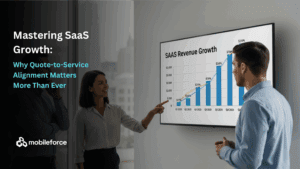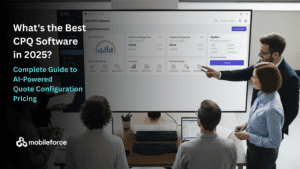

Mobileforce
- General Resources
Table of Contents
Toggle“Feels like we’re heading into a storm with no umbrella,” Sarah mutters as she scrolls through yet another vendor email announcing the end-of-sale for Salesforce CPQ. As CIO of a mid-market manufacturing company, she’s staring down a decision that ripples through every integrated system, every compliance audit, and every forecast her IT organization owns. And she’s not alone.
Her morning starts with her Salesforce admin flagging update issues in their current CPQ configuration. They’ve been clamoring for new features in Salesforce CPQ for years, but now it looks like these will never be implemented. Next comes the Compliance team, raising alarms about access control concerns with Pricing data across regions. Then Marcus from Sales Ops knocks—his team’s discount approval workflows are breaking down, quote templates are inconsistent across regions, and they’re losing deals because complex configurations take too long to set up, get approvals for, and to close.
And now this: the end of life of Salesforce CPQ would necessitate a mandatory platform migration to Salesforce Revenue Cloud Advanced. However, this migration requires a complete rebuild of the custom field extensions to managed objects, the product, pricing, and approval rules. All the apex code their team has spent years developing and fine-tuning for workflow and orchestration would need to be revisited in light of Business APIs and Flow that are both new to RCA. Worse, her Sales Ops team has spent months working on evaluating Salesforce RLM and while they think RLM and RCA are the same, they’re not quite sure. Frankly, they don’t believe they’ll need all the features of RCA, nor can they jeopardize current sales deliverables while undertaking such a significant rewrite.
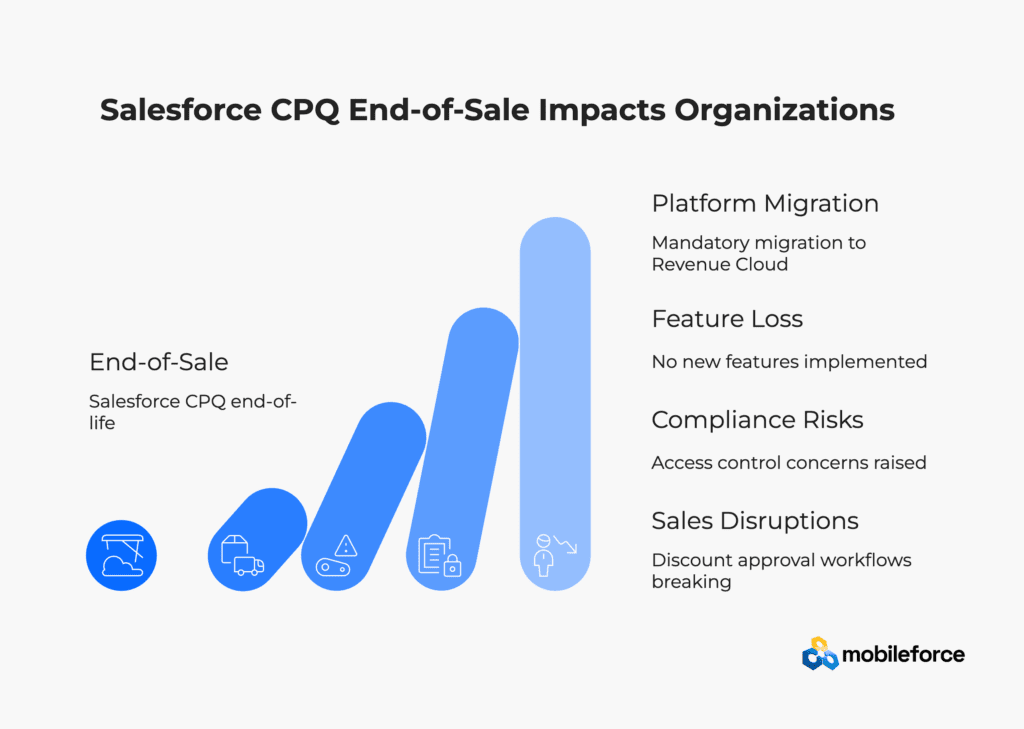
Perhaps it’s time to evaluate other CPQ vendors? After all, existing inefficiencies and skill sets needed to overcome them can best be realized by starting afresh. However, this would mean getting Procurement to dig deep into evaluating dozens of vendor proposals.
Each stakeholder brings different priorities, but Sarah is responsible for all of them. She needs a solution that checks every box— (1) functional parity with current CPQ. (2) improved core-functionality that simplifies current configuration, pricing, quoting and approval complexities, thus improving sales efficiency. (3) Superior pricing engine to support modern subscription pricing. (4) Guardrails around discounting and approvals and most of all. (5) supporting new pricing: such as amendments, renewals, and cross-sell and (6) supporting all sales channels such as channels, partners, and even customers. To top it all, the chosen solution needs to account for the enterprise architecture alignment, regulatory compliance, and cost control—all at once.
If you’re a CIO, Sarah’s plight is not too far removed from yours. Salesforce’s official announcement has moved CPQ migration from “someday priority” to “urgent business imperative” for thousands of organizations and defines how your sales teams and sales operations support revenue generation for years to come. Simplicity is what CIOs such as Sarah pine for.
Introduction: The Clock Is Ticking on Salesforce CPQ
For organizations that have embedded Salesforce CPQ deeply within their integrated technology stack, migration is a major architectural decision affecting sales process efficiency, and operational continuity.
Your enterprise architecture depends on seamless data flow between CPQ, ERP, CRM, and financial systems. Any disruption could cascade through invoicing, order processing, and inventory management. Your IT Admins have spent years configuring complex integrations that somehow work—until vendor support disappears.
Meanwhile, your Sales Ops team faces operational chaos. Marcus knows that broken approval workflows mean deals stall in the pipeline. Inconsistent pricing rules create compliance risks and margin erosion. When quote generation takes hours instead of minutes, competitive deals are lost before they start. The technical debt in your current CPQ isn’t just an IT problem—it’s directly impacting revenue velocity and sales productivity. Your Compliance team faces the reality of running unsupported software in regulated environments.
The right migration approach can modernize your quote-to-cash infrastructure while strengthening your overall IT governance framework and accelerating sales operations. The wrong choice—or analysis paralysis—could mean system instability, escalating technical debt, and declining sales performance. Migration creates the opportunity to fix inefficiencies—from configuration through approvals—and to integrate channel and distribution partners into the CPQ workflow. Savvy CIOs make simplicity non‑negotiable in migration design to ensure easy maintenance and evolution.
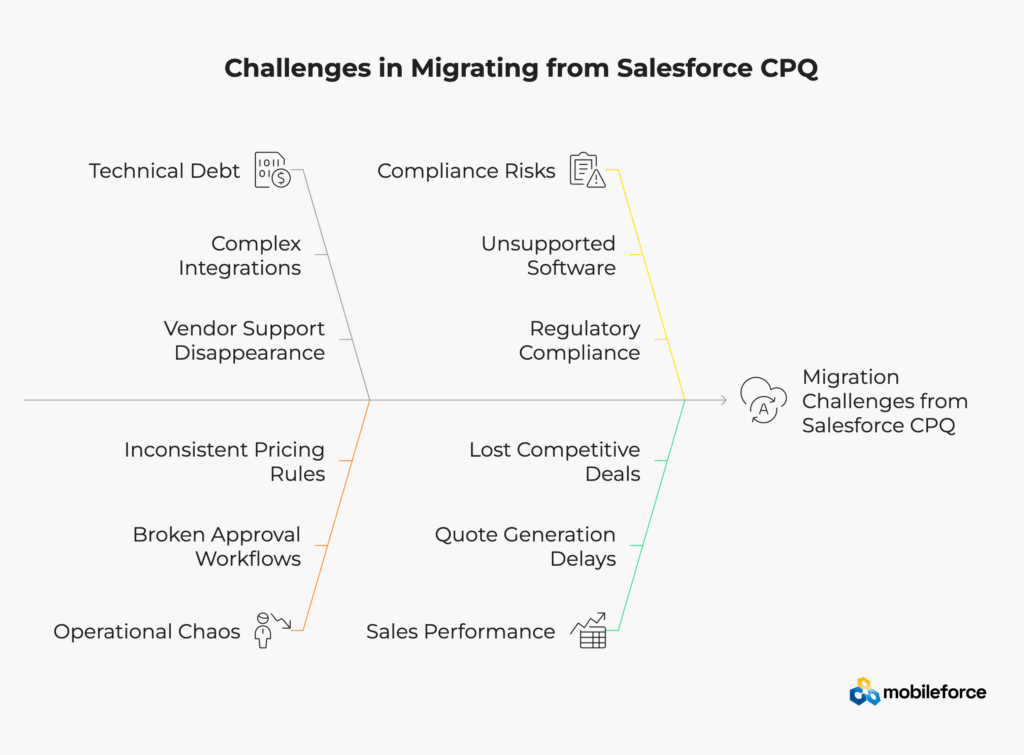
What Sales Ops Leaders & CIOs Are Really Worried About: Beyond the Surface-Level Sunset
While Salesforce’s official EOS announcements focus on product sunsetting and licensing changes, it’s worth looking into the implications for IT leadership and sales operations. Specifically, here are the core concerns that keep both Sales Ops VPs and CIOs awake when planning CPQ migration strategy.
What Sales Ops Leaders Are Worried About
Sales Ops Concern | What a Modern CPQ Must Deliver |
Approval Workflow Breakdown | Flexible, Visual Approval Designers |
Complex approval chains break when business rules change. Sales deals stall waiting for approvals that should be automated, while high-risk discounts slip through without proper review. | Drag-and-drop approval workflow builders that business users can modify without IT intervention, with clear audit trails and escalation paths. |
Inconsistent Pricing & Discounting |
Centralized Price Management
|
Different regions, product lines, or sales channels using different discount structures create margin erosion, compliance risks, and competitive disadvantages. | Unified pricing engines with role-based discount authorities, automated competitive pricing, and real-time margin analysis across all sales channels. |
Quote Template Chaos | Template Standardization & Personalization |
Sales reps create custom proposals that don’t reflect current pricing, legal terms, or brand standards. Manual document generation slows deal cycles and creates legal exposure. | Professional template libraries with automated data population, legal-approved language, and customization options that maintain brand consistency. |
Performance & User Adoption Issues | Intuitive User Experience |
If the CPQ is slow or difficult to use, sales reps will find workarounds that bypass controls and create data quality problems. SalesforceBen.com reports that poor usability forces “users to work on quotes separately, continuously switching between them, hindering productivity and quote turn-around timing.” | Mobile-optimized interfaces, fast quote generation, and intuitive workflows that sales teams want to use instead of avoiding. |
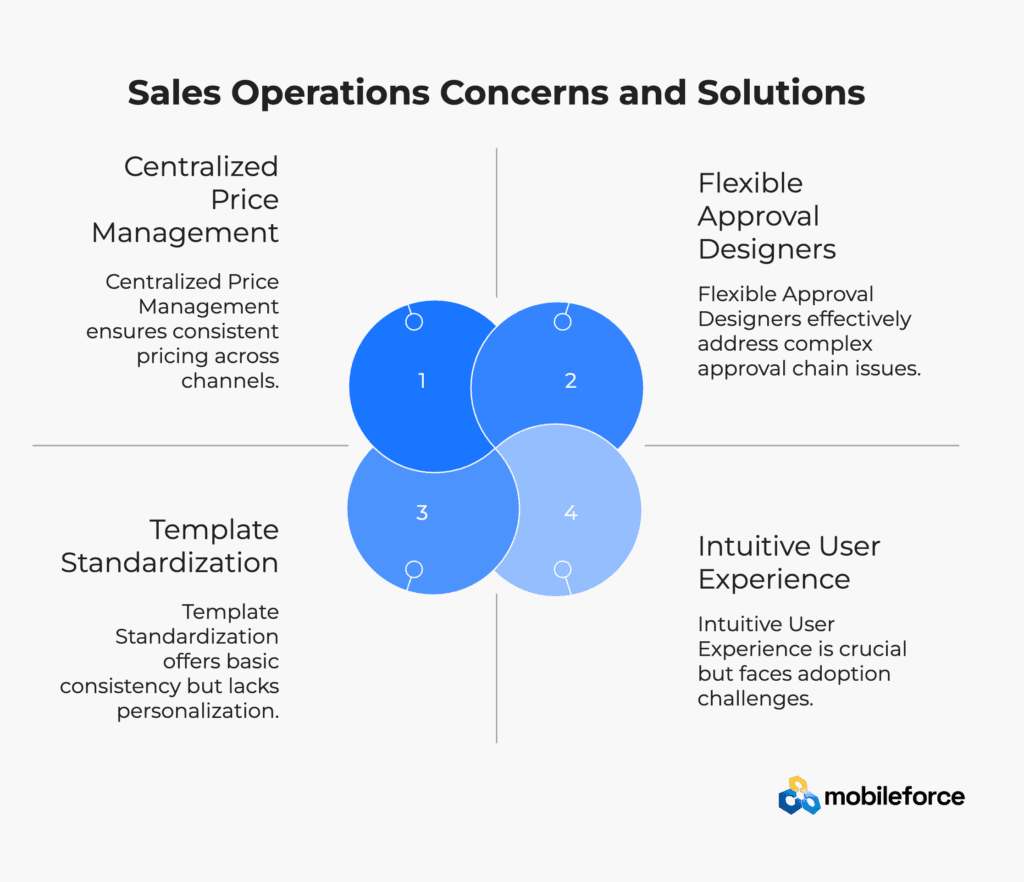
What CIOs Are Worried About
CIO Concern | What a Future-Ready CPQ Solution Must Include |
System Integration Failure | Architecture Integration Flexibility |
Breakage in ERP, CRM, and inventory workflows during migration can stall revenue recognition and disrupt downstream operations. CIOs need to protect mission-critical processes as they modernize. | Support for RESTful APIs, standard data formats (JSON/XML), and pre-built connectors that ensure clean integration with legacy systems without needing a full rewrite. |
Technical Debt & Maintenance Overhead | Admin Control & Low Maintenance |
Legacy CPQ systems often contain a tangle of hard-coded logic, fragile Apex scripts, and undocumented workflows that create hidden risk and slow down every change request. Implementing, developing, and maintaining Salesforce CPQ can be complex, with unique challenges for developers, admins, and CPQ specialists. | Low-code rule configuration, visual builders, and clear documentation that empower IT admins to manage business logic without relying on developers. |
Performance Issues & System Instability | Scalable Architecture & Predictable Performance |
“Processing price rules and calculations for thousands of quote lines puts pressure on the system, performance declines, and the work of your CPQ users slows down,” according to an industry insight. Users can be “stopped dead in their tracks after spending considerable time on a quote.” | Enterprise-grade performance optimization, predictable scaling, and system monitoring that prevents performance degradation under load. |
Innovation Velocity Constraints | Scalable Rule Engine Architecture |
Outdated CPQ tools slow down your ability to adopt AI-powered recommendations, dynamic pricing, or self-service quoting. The platform becomes a ceiling on progress. | Modular, testable rule engines with versioning, rollback, and sandbox environments that allow fast experimentation and safe iteration at scale. |
Escalating TCO | Modular, Usage-Aligned Pricing Models |
Overpaying for bundled features you don’t use—or needing expensive consultants for basic changes—creates a total cost of ownership misaligned with business value. | A modern CPQ should offer à-la-carte pricing, flexible deployment models, and no hidden fees for scalability, customization, or support. |
Security & Compliance Exposure | Built-in Security & Compliance Frameworks |
Running unsupported software introduces risk to SOX, HIPAA, and ISO compliance. When systems are difficult to use, these prompt[s] users to pull data out of Salesforce and work from offline spreadsheets, creating additional compliance risks. | SOC 2 Type II certification, field-level permissions, audit logs, encryption at rest, and compliance toolkits should be table stakes—not add-ons. |
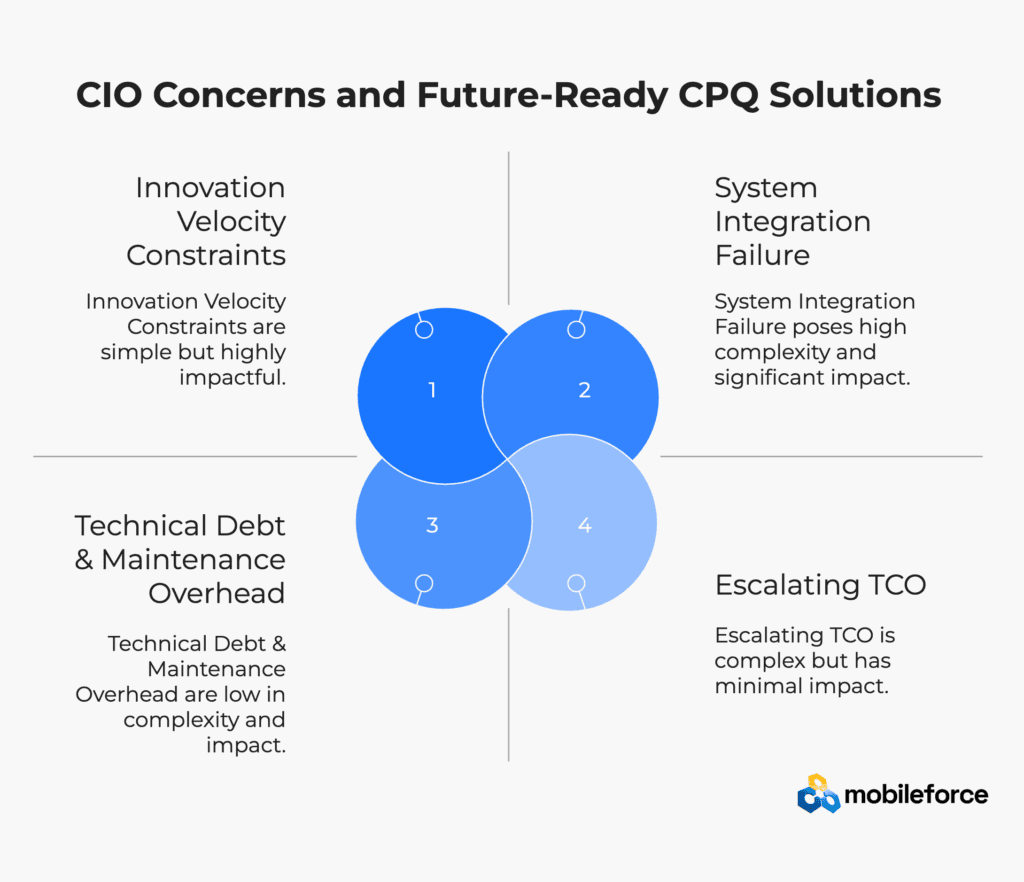
Introducing Mobileforce CPQ: Built for CIO and Sales Ops Priorities
Mobileforce CPQ represents a next-generation CPQ platform designed specifically to address both IT leadership modernization requirements and Sales Operations efficiency needs. Unlike traditional CPQ solutions that create new architectural dependencies, Mobileforce CPQ strengthens your existing technology foundation while providing advanced sales capabilities.
Enterprise Architecture Integration
Mobileforce CPQ offers native compatibility with major CRM platforms (Salesforce, HubSpot, Microsoft Dynamics, SugarCRM, Creatio, Zendesk, etc.) and custom systems through comprehensive RESTful APIs. The platform integrates seamlessly with ERP systems, billing platforms, and business intelligence tools using standard protocols that your IT Admins can manage and monitor effectively.
This microservices-compatible architecture supports flexible deployment models—from CPQ-only implementations to comprehensive quote-to-service platforms—without forcing unnecessary architectural changes or vendor lock-in decisions.
Administrative Control and Sales Operations Governance
The platform features visual configuration interfaces that empower both your IT Admins and Sales Ops teams to manage business rules, approval workflows, and integration parameters without custom coding. Rule libraries support versioning, testing, and rollback capabilities essential for enterprise change management.
For Sales Ops leaders like Marcus, this means building complex approval chains using drag-and-drop designers, setting up automated pricing rules that adapt to market conditions, and creating quote templates that maintain compliance while giving sales teams the flexibility they need. Changes can be implemented and tested without waiting for developer resources or risking system stability.
This approach addresses a common Salesforce pain point highlighted by both IT professionals and Sales Operations teams: the complexity of maintaining custom Apex code and the dependency on specialized developers for routine configuration changes. Mobileforce CPQ’s no-code approach reduces these maintenance overhead concerns while improving both system reliability and sales process agility.
Security and Compliance Foundation
SOC 2 Type II compliance ensures the platform meets enterprise security standards your Compliance team requires. HIPAA readiness supports regulated industries, while comprehensive audit trails, SSO integration, and role-based access controls satisfy internal governance requirements.
Real-time logging and administrative reporting provide the visibility your Compliance specialists need for regulatory audits and security assessments, while giving Sales Ops teams the deal analytics and performance metrics that they need for process optimization.
Vendor Partnership and Support Model
Your Procurement team benefits from Mobileforce CPQ’s transparent pricing model, proven customer support framework, and clear product roadmap. The vendor maintains financial stability with established enterprise customers while providing professional services capabilities that support complex implementations.
Unlike many CPQ vendors that focus primarily on sales teams, Mobileforce CPQ designs solutions with IT requirements as primary considerations—understanding that sustainable implementations require strong technical foundations that support both system reliability and sales performance.
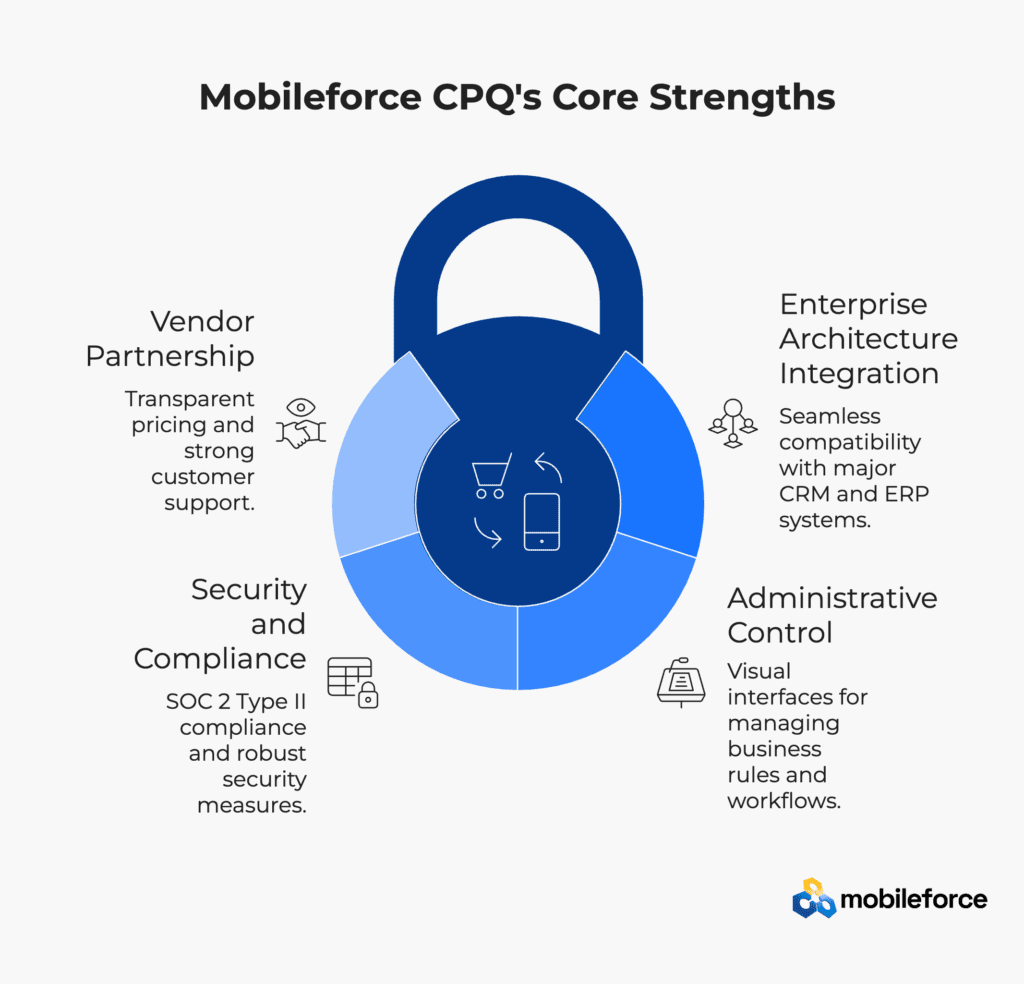
Why This Is More Than Migration—It’s IT Application Modernization
If we think deeper, this transition is much more than replacing Salesforce CPQ. In fact, it’s about modernizing your application stack while strengthening quote-to-cash capabilities.
The Cloud Sprawl Problem
First, your current architecture forces you to manage multiple cloud environments. You have Salesforce CRM in one cloud system. You have Salesforce CPQ as a managed package that operates in a separate namespace, even though it’s installed within Salesforce. Then you have ERP, billing, and analytics systems sitting in their own cloud environments. How many disparate cloud applications are you managing, and how much technical debt is this creating?
From Fragmented Systems to Unified Architecture
Secondly, traditional CPQ implementations often create isolated systems that require custom integration work and ongoing maintenance overhead. Each system operates in its own namespace with its own update cycles, security models, and administrative requirements. But modern platforms like Mobileforce CPQ follow enterprise application architecture principles, providing standard APIs, comprehensive monitoring, and administrative tools that align with IT governance frameworks while consolidating your application management overhead.
Empowering Teams Through Modern Design
Instead of hardcoded business rules requiring developer intervention, modern platforms offer visual configuration tools that empower your IT Admins to implement changes following standard change management processes. Rather than vendor-specific integration patterns, you get standard protocols that work with your existing monitoring and management tools.
Strategic Technology Flexibility
Also, the shift from platform-specific architectures to composable, API-first designs provide strategic flexibility for future technology decisions. Technologies like SSO integration and headless architecture become essential for creating seamless user experiences across your application portfolio. Most importantly, moving from fragmented application stacks to integrated platforms reduces the total number of cloud environments your IT team must manage while improving overall system reliability.
Benefits Across All Teams
Lastly, your IT Admins gain administrative control without depending on specialized consultants for routine modifications. Your Sales Ops team gets the workflow flexibility and performance they need without creating technical debt. Your Compliance team gets built-in audit capabilities rather than bolt-on security measures. Your Procurement organization reduces vendor management overhead while improving service quality.
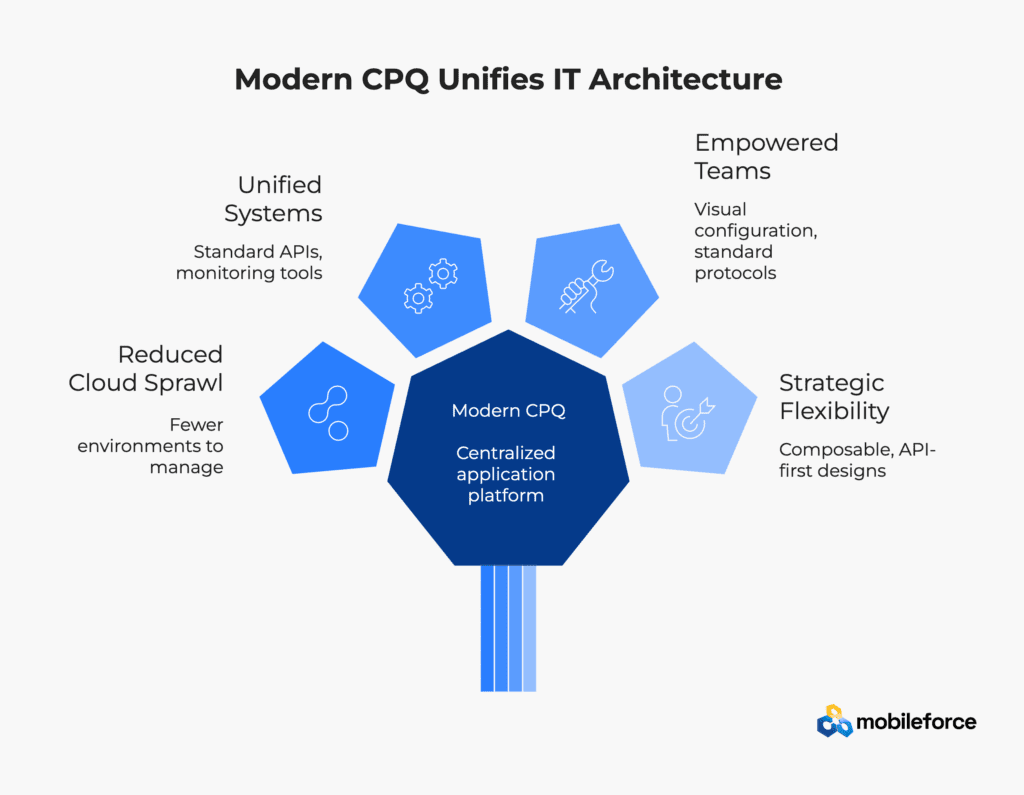
The Mobileforce CPQ Migration Blueprint for IT Leaders
Approach CPQ migration using proven enterprise architecture principles that protect existing investments while modernizing capabilities. Mobileforce CPQ supports multiple migration scenarios to ease your transition:
Migration Scenario Options
Scenario 1: CPQ-First Migration (Business Continuity Priority)
- Replace Salesforce CPQ with Mobileforce CPQ immediately—quotes can’t wait
- Maintain Salesforce CRM integration during transition
- Evaluate CRM alternatives over 3–6-month timeline while CPQ operates seamlessly
- Why this works: Daily quote generation continues uninterrupted while you plan strategic CRM decisions
Scenario 2: Side-by-Side Evaluation
- Maintain Salesforce CRM + Salesforce CPQ in production
- Deploy Mobileforce CPQ in parallel for testing and comparison
- Gradual transition with rollback capabilities
Scenario 3: Integrated CRM Migration
- Keep Salesforce CRM as your system of record
- Replace Salesforce CPQ with Mobileforce CPQ
- Maintain existing CRM workflows and user experience
Scenario 4: Complete Platform Migration
- Migrate from Salesforce CRM to alternative platforms (SugarCRM, HubSpot, Dynamics, Creatio, Zendesk, etc.)
- Implement Mobileforce CPQ as integrated quote-to-cash solution<span data-ccp-props=”{“134233117″:false,”134233118″:false,”335559738″:0,”335559739″:0}”>
- Consolidate application stack and reduce cloud management overhead
Migration Phases
Phase 1: Technical Architecture Assessment
Document current system integrations, data flows, and performance requirements. Your IT Admins should catalog existing APIs, middleware components, and monitoring configurations. Identify compliance requirements and security standards that must be maintained throughout migration.
Sales Ops teams should map current approval workflows, pricing rules, and quote templates to ensure business continuity during transition.
Phase 2: Integration Design and Planning
Design migration architecture that preserves critical business processes while modernizing underlying technology. Map data transformation requirements and integration testing procedures. Your Compliance team should validate that security controls meet regulatory requirements.
Sales Operations should design new approval workflows and pricing rules using Mobileforce CPQ’s visual configuration tools, ensuring improved efficiency without disrupting active deals.
Phase 3: Controlled Migration and Testing
Implement phased migration using established change management procedures. Your IT Admins configure new platform settings using documented procedures that support rollback if needed. Validate system performance and integration reliability before expanding deployment scope.
Sales Ops teams should conduct parallel testing of quote generation, approval workflows, and pricing calculations to ensure accuracy and performance improvements.
Phase 4: Administrative Training and Documentation
Train your IT team on platform administration, monitoring procedures, and troubleshooting workflows. Create standard operating procedures that align with existing IT governance frameworks. Your Compliance specialists should validate audit trail configurations and access control implementations.
Sales Operations teams receive training on workflow configuration, pricing rule management, and performance analytics to enable ongoing optimization without IT dependencies.
Phase 5: Production Deployment and Optimization
Deploy using proven enterprise rollout methodologies with appropriate monitoring and support procedures. Monitor system performance, integration reliability, and user adoption metrics. Optimize configurations based on production usage patterns while maintaining compliance requirements.
Most Mobileforce CPQ enterprise customers complete migration within 8-16 weeks using this structured approach, achieving improved system reliability, reduced administrative overhead, and enhanced sales process efficiency from initial deployment.
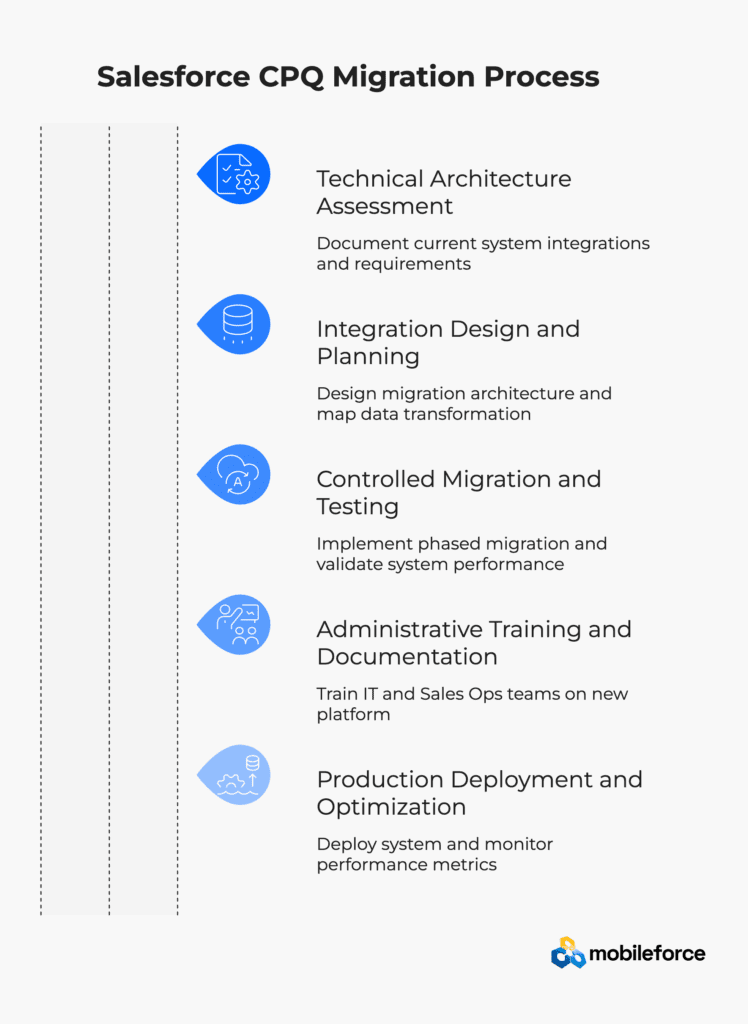
CIO Takeaways: What Future-Proof CPQ Architecture Looks Like
Planning for the next decade of quote-to-cash technology requires platforms that strengthen rather than complicate your application architecture.
Your future CPQ must integrate seamlessly with existing systems rather than requiring architectural compromises. Administrative tools should empower both your IT team and Sales Operations to manage configurations using standard procedures without specialized training. Security and compliance capabilities must be built into platform architecture rather than requiring additional vendor relationships.
Performance and reliability should meet enterprise SLA requirements under production loads while delivering the fast quote generation and approval processing that Sales Operations demands. Vendor partnerships should reduce rather than increase your Procurement team’s management overhead. Most importantly, the platform should support your organization’s long-term technology strategy rather than creating new cloud management dependencies.
Modern CPQ platforms serve as application infrastructure components that strengthen your overall technology foundation while enabling advanced business capabilities. The migration decision you make today will affect system reliability, administrative overhead, sales process efficiency, and vendor management complexity for years to come.
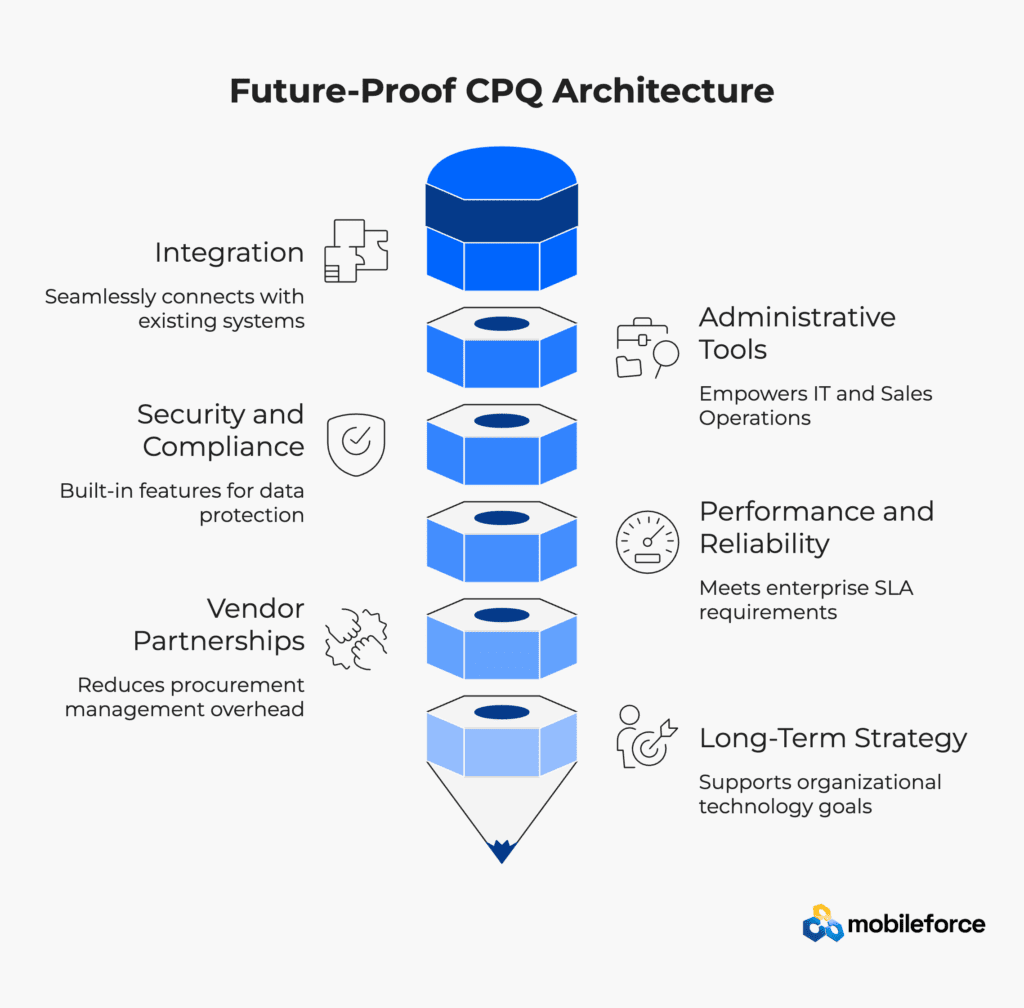
Ready to Modernize Your Quote-to-Cash Application Stack?
The Salesforce CPQ end-of-life timeline creates urgency, but also an opportunity to modernize your application stack using enterprise architecture principles. With Mobileforce CPQ, you don’t just migrate—you strengthen your IT foundation while enabling advanced sales operations capabilities. As CIO, the architecture decisions you make during this migration will define your technology flexibility and operational efficiency for years ahead.
Request a demo or technical architecture assessment from Mobileforce CPQ to explore how IT leaders are modernizing quote-to-cash applications while reducing operational complexity.
FAQs
1. What does the end-of-sale for Salesforce CPQ mean for my business?
The end-of-sale for Salesforce CPQ means that Salesforce will no longer sell or support the CPQ product. This signals an urgent need for businesses to migrate to a new solution, ensuring continued support and the ability to scale with future business needs.
2. Why should I consider migrating from Salesforce CPQ?
Salesforce CPQ’s end-of-sale status means your company will no longer receive updates, patches, or support. Migrating to a modern CPQ solution ensures you stay current with technology trends, maintain system security, and streamline your quote-to-cash processes without risking operational inefficiencies.
3. What are the risks of not migrating from Salesforce CPQ?
Failure to migrate can lead to unsupported software, security vulnerabilities, compliance risks, and operational inefficiencies. Additionally, outdated systems can slow down sales processes, leading to lost revenue and decreased customer satisfaction.
4. What features should a modern CPQ solution have?
A modern CPQ solution should have:
Seamless integration with existing CRM, ERP, and financial systems
Visual and flexible approval workflows
Unified pricing engines with real-time margin analysis
Scalable and performance-optimized architecture
No-code configuration options for easy customization and updates
Built-in security and compliance features (SOC 2, HIPAA, etc.)
5. How do I ensure a smooth CPQ migration?
A smooth migration involves:
Assessing your current system architecture and integration points
Designing a migration strategy that minimizes disruption
Leveraging a CPQ solution with flexible integration capabilities
Training internal teams on new processes and tools
Conducting parallel testing to ensure functionality before full deployment
6. What is the difference between Salesforce Revenue Cloud and other CPQ solutions?
Salesforce Revenue Cloud is a premium solution that combines CPQ with billing and revenue recognition. While it integrates well with Salesforce CRM, it may not be necessary for all businesses. Alternative CPQ solutions, such as Mobileforce CPQ, offer a more customizable approach without the complexity of full platform migrations.
7. Can Mobileforce CPQ integrate with other CRM platforms besides Salesforce?
Yes, Mobileforce CPQ supports integration with a variety of CRM platforms, including HubSpot, Microsoft Dynamics, SugarCRM, and Zendesk, through RESTful APIs, making it a flexible option for businesses looking to integrate CPQ across different systems.
8. How can Mobileforce CPQ simplify approval workflows?
Mobileforce CPQ offers drag-and-drop approval workflow builders, which allow business users to create, modify, and automate approval chains without requiring IT intervention. This ensures faster deal closures and greater flexibility for Sales Ops teams.
9. What makes Mobileforce CPQ secure and compliant?
Mobileforce CPQ is SOC 2 Type II certified, ensuring it meets high-security standards. It also supports HIPAA readiness and provides built-in compliance tools, including audit trails, encryption, and role-based access controls, making it a reliable solution for regulated industries.
10. How long does it take to migrate from Salesforce CPQ to Mobileforce CPQ?
Migration timelines vary based on your organization’s size and complexity, but most businesses complete the migration in 8 to 16 weeks. This includes a structured approach involving system assessment, integration design, phased migration, and user training.
These FAQs help address common concerns around the Salesforce CPQ end-of-sale transition and guide businesses toward selecting a future-proof CPQ solution.
